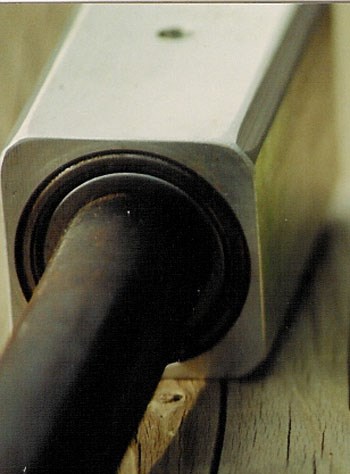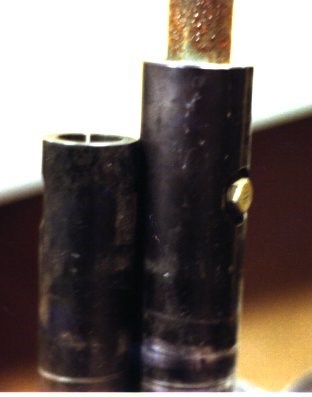Quicksilver MX drive train troubleshooting
Quicksilver MX Root Tube Bearing Wear - MX pilots have reported vibration in their aircraft, upon further examination it was found that a collar inside the root rube which the top pulley shaft goes through had begun to wear, allowing the bearing which it retains to move causing the vibration.
It was generally found that all these aircraft had more than 100 hours on them. A solution to the problem is to drill a hole through the root tube directly in front of the bolt that holds the collar and install another bolt. What this does is holds the collar in place and takes the strain off of the bearing and collar, by giving support to the collar at two locations instead of one. Of course if you have already started to feel the vibration then the bearing is probably gone and must be replaced.
There is also a retrofit available which replaces the round bearing retaining collar with a new solid aluminums insert which fits snugly into the root tube, and which has a drilled out section for the bearing to fit into eliminating the need to drill the second hole.
Quicksilver MX Pillow Block Bearing Failure
MX pilots have reported that the pillar block bearing used to tension the belts on the back end of the driveshaft has
1. seized up
2. worn into the driveshaft 3. become worn out.
It is suggested that this be a regular area of inspection and that at the first sign of wear, that this pillar bearing be replaced.
Image Courtesy of http://fitzvideo.com/
Quicksilver MX drive shaft coupler failure
Several ultralight pilots have reported loss of propulsion both on the ground and in the air. Upon closer examination it was found that the coupler connecting the driveshaft to the engine had broken in half.
In several other cases the bolt connecting the shaft to the coupler had severed. The bolt severing incidence were generally after the craft had been flown for 50 or 60 hours with an untraceable vibration, generally at idle and around 5,000 RPM.
A possible solution to this problem is to replace the coupler with a new style which is nearly twice the diameter plus substantially longer. (these are generally found on the newer Rotax powered aircraft).
Older style Quicksilver coupler on left, newer longer, thicker coupler on right.
Quicksilver MX drive shaft coupler failure
Another solution is to replace the coupler with a flex drive coupler, which eliminates most vibration. Another problem encountered with the coupler is that of the bolt retaining the coupler to the crankshaft coming loose or, if removed not being properly tightened, when reinstalled.
This allows the coupler to spin on the crankshaft, generally ruining the coupler. A pilot with a loose bolt will notice his engine revving up while under load, similar to what would happen if his drive belts were loose.
Flex Coupler located on end of driveshaft, if used on MX the rear downtubes have to be repositioned for clearance.
Quicksilver MX Reduction Drive Troubleshooting
Another area of slippage is on the two seat MX on the large reduction drive pulley. On the side of the pulley are located two bolts for tightening the pulley on to the upper driveshaft.
The manufacturer recommended that loctite be applied between the pulley and shaft and then that the bolts be tightened this helps prevent the pulley from turning on the shaft.
On two seat aircraft the bolts were and AN 5 rather than the AN 4 used on the singles.
The manufacturer also changed the kind of driveshaft they were using from a hollow shaft with an aluminums plug to a solid shaft, for more information on this you should
contact a Quicksilver service outlet or the factory.
Well its taken some 3 months, and 5 rewrites to get this all down on paper, I hope that it is of some use to fellow MX owners and pilots.
U.B. Judge




